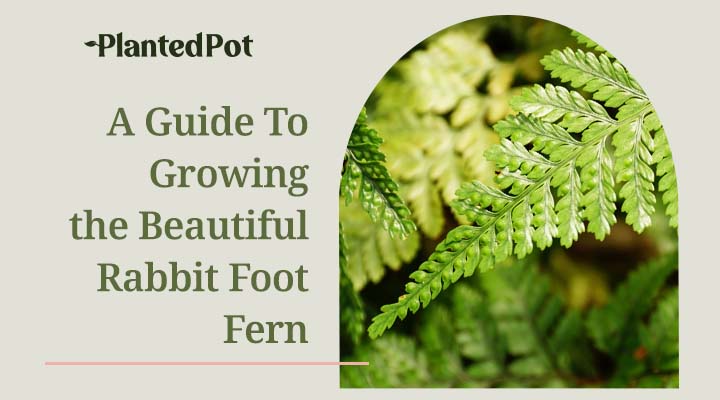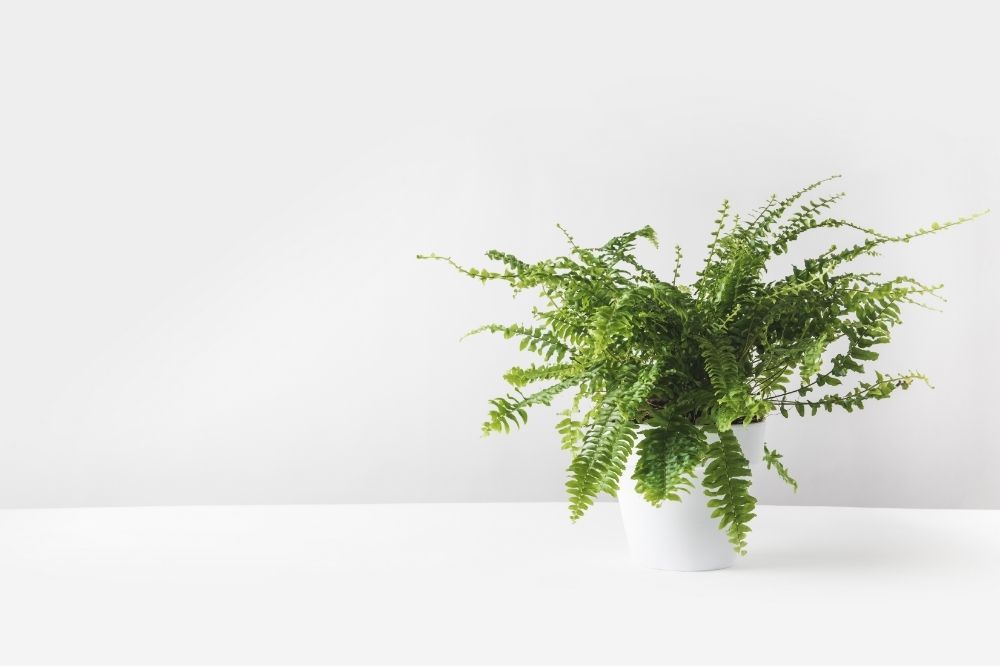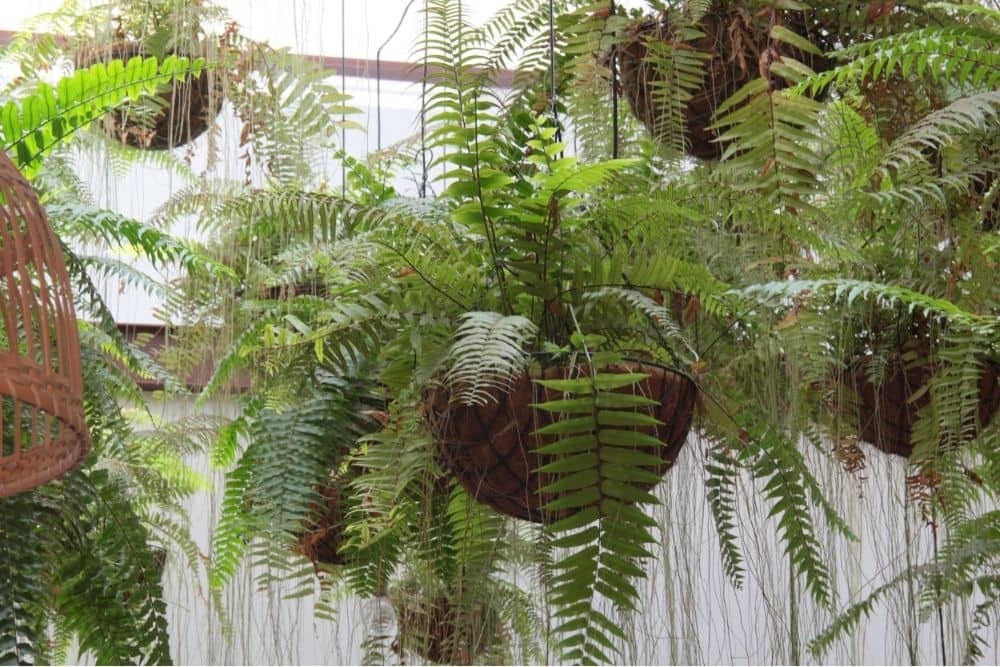
Rabbit Foot Fern Care: The In-Depth Guide for This Easy Houseplant!
Home / Rabbit Foot Fern Care: The In-Depth Guide for This Easy Houseplant!

Rabbit Foot Fern Care: The In-Depth Guide for This Easy Houseplant!
- Kyle Chin
- March 30, 2021
- 10:09 pm
- No Comments
The Rabbit Foot Fern is an eye-catching tropical plant that is easier to take care of than most other ferns. As its name suggests, Rabbit Foot Ferns are considered lucky in many parts of the world due to their unique fuzzy rhizomes that cover the base of the plant. This unique, luscious plant makes a fantastic accessory to any home, especially as a hanging decoration.
With its low maintenance needs and strong resiliency, Rabbit Foot Ferns (also called Rabbit’s Foot Ferns) are quickly becoming a fan-favorite houseplant. Learn a few of the best tips and tricks for taking care of these beautiful plants and how your living space can benefit from them!
What is a Rabbit Foot Fern?
The Rabbit’s Foot Fern (Davallia fejeensis) is an epiphytic fern that originates from the tropical forests of the Fiji islands. As an epiphytic plant, it typically grows on the surfaces of trees or rocks, taking its nutrients from moisture in the air, surfaces, and any debris that falls from the forests above. As a result, Rabbit Foot Ferns are hardy and adaptable plants that grow well in many environments.
The most distinguishable feature of this plant is its furry rhizomes that peek over the top of the soil. These yellowish-brown rhizomes are the plant’s fleshy roots that sprout upwards, absorbing all the moisture and nutrients from the soil or surface.
The rhizomes are covered with hairs that are reminiscient of furry rabbit feet, although sometimes this plant is also referred to as a “Squirrel’s Foot Fern.” They can often grow out and over the side of the pot, giving it an alluring, one-of-a-kind appearance.
The Rabbit’s Foot Fern can grow up to about 2-3 feet long and about 6 inches wide. This fern is well-suited to a floor planter or a hanging pot. Because the foliage and rhizomes are long enough to hang over the side of the pot, many people recommend displaying the Rabbit’s Foot Fern as a hanging plant. Additionally, hanging the Rabbit Foot Fern in the air adds a distinct pop of color in any room!
Are Rabbit Foot Fern Plants Easy to Care For?
Yes, Rabbit Foot Ferns are easy to care for! Generally, ferns need high humidity to thrive. Though, Rabbit Foot Ferns are very resilient and much easier to please as indoor houseplants as opposed to wild ferns. With modern plant misters and humidifiers, you won’t have to become a botanical expert to care for a Rabbit Foot Fern.
Can You Grow Rabbit Foot Ferns Indoors and Outdoors?
The Rabbit’s Foot Fern can be grown both indoors and outdoors! The Rabbit’s Foot Fern already grows naturally in the tropical forests of Fiji, but it is also very tolerable of less humid climates and indoor environments. However, the Rabbit’s Foot Fern is more sensitive to cold temperatures and dry air, so try to avoid these conditions when growing your plant.

What Are the Benefits of a Rabbit Foot Fern Plant?
There are many benefits and advantages for your health that come with owning an indoor plant!
- Better air quality – Indoor plants can absorb the harmful gasses and chemicals in the air like formaldehyde, xylene, and toluene. Plants can also act as a natural air purifier by recycling the carbon dioxide in the air and producing fresh oxygen for us to breathe. Indoor air can have just as many pollutants as the outdoors, and having plants to help cleanse the air can help us focus and clear our heads better.
- Psychological benefits – Did you know that having plants around the house or at your desk can help you feel more relaxed and reduce stress? This 2015 study examined the relationship between plants and people. Many test subjects reported feeling less stressed and more focused after interacting with the plant for just a few minutes a day. It has also been suggested that living with plants can aid blood pressure and heart rate.
Since Rabbit Foot Ferns are relatively easy to care for, many people choose this plant as their first one to own. By refreshing the air around it, this remarkable plant can help you de-stress and clear your head!
Rabbit Foot Fern Plant Care Tips
Caring for a Rabbit Foot Fern is very straightforward and easy. As long as you keep them in moist conditions with plenty of room to grow, they will become excellent complements to your household. The following are some of our top care tips for Rabbit Foot Ferns.
Finding the Right Pot
Rabbit Foot Ferns have a shallow root system that only grows a few inches long. You can use a shallow pot or hanging basket for the best results. Shallow containers can help you save more soil in the long run.
Even though Rabbit Foot Ferns love moisture and water, it is still important to have a well-draining pot to avoid root rot. Trapping too much water in the soil without allowing it to drain can cause the plant to become over-saturated and eventually damaged.
If you hang your plant, be sure to get a container that comes with a drainage tray. This isn’t necessary if you don’t mind some dripping water, but it makes clean-up much easier.
Rabbit Foot Ferns are slow-growing plants that don’t need to be repotted often. Generally, you will only need to repot once every 2-3 years. However, if you notice the rhizomes or roots outgrowing the pot, you can switch to a pot that is slightly wider to accommodate for the growth.
Choosing the Right Soil
Many types of soil can provide the necessary nutrients for your Rabbit Foot Fern. Choose a loose, well-draining, moist potting mix, so it doesn’t hold in too much moisture. You don’t want the soil to be overly moist, as this can cause root rot.
Most peat-based, neutral pH potting mixes will provide the nutrients your Rabbit Foot Ferns need to thrive. You can create your own blends as well. An excellent and simple formula we recommend is:
- 2 parts standard or peat-based potting soil
- 1 part sand or perlite
- 1 part chopped bark
Watering Your Rabbit Foot Fern Plant
As a tropical plant, your Rabbit Foot Fern thrives in humid and moist climates. They are used to having plenty of moisture, so be sure the soil doesn’t dry out completely.
Remember that Rabbit Foot Ferns have short roots, so once the first inch or so of soil has dried out, it is time to water the plant again. Try to keep the soil moist but not soaked to avoid root rot.
Rabbit Foot Ferns are also sensitive to salt and mineral content, so you may want to use distilled or filtered water.
The rhizomes creep over the surface of the soil and absorb the water for storage. The rhizomes help keep the plant alive even when you forget to water it!
Feeding Your Rabbit Foot Fern Plant
Typical growing seasons for plants are usually around spring and summer, so plan to fertilize your Rabbit Foot Fern during these warmer seasons.
Use a half-strength or diluted liquid fertilizer about once every 2-3 weeks from the beginning of spring to the end of fall for best results. You don’t need to feed the plant during the winter since plants are usually dormant and don’t grow in the cold seasons.
If you have just repotted your Rabbit Foot Fern, don’t fertilize it for at least a month to allow the roots to adapt to the soil. Without a chance to acclimate, your plant’s roots could experience “fertilizer burn.”
What is fertilizer burn? Fertilizer contains salt, which is beneficial to plants, but too much can draw large amounts of moisture out of the plant. This process is called fertilizer burn, because the leaves appear yellow (or “burned”) due to the lack of water.
Rabbit Foot Fern Placement and Lighting
Like most other epiphytic plants, Rabbit Foot Ferns thrive with bright, indirect light, similar to the filtered sunlight from the trees it grows on. Exposure to direct sunlight may cause damage to the plant, so place it near a window where it can receive plenty of indirect light.
A north or east-facing window may be an ideal placement for your Rabbit Foot Fern. If you don’t have proper windows that allow sufficient sunshine in, fluorescent lights will also work.
Humidity and Temperature
Similar to the classic Monstera Deliciosa, Rabbit Foot Ferns prefer humid and warm climates like the tropical forests they come from. Ideally, you want to keep the temperature around 60-75°F and no lower than 55°F. Rabbit Foot Ferns are sensitive to the cold and chilly drafts, so make sure that it is placed in a protected area shielded from frigid air or wind.
You can help boost moisture content by misting your Rabbit Foot Fern daily. However, one of the best ways to increase humidity is to use a humidity tray. Simply fill a saucer with pebbles or rocks and about a half-inch of water. Place the pot on top of these pebbles so that it can absorb the moisture that evaporates into the air.
Pruning a Rabbit Foot Fern
Rabbit Foot Fern’s rarely need grooming or pruning. They aren’t considered invasive or aggressive growers, so it’s up to you whether you want to trim for aesthetic purposes.
If you notice any browning or spotting, you can use clean, sharp plant shears to neatly clip out the affected areas. Avoid trimming your Rabbit Foot Fern if you feel it is overgrowing the pot, as this can stunt its growth. Instead, switch to a bigger pot that will allow the plant a bit more room.

Common Issues Found in Rabbit Foot Ferns
Here are some of the most common issues people have encountered when growing their Rabbit Foot Ferns:
- Yellowing leaves – Yellow leaves with dry brown tips are the most common result of under-watering, dry climates, excessive fertilization, or temperatures that are too hot.
- Pale, light green fronds (leaves) – Some plants have pale leaves, like the Calathea. Other have deep, dark leaves, such as the Philodendron and Rabbit Foot Fern. If your Rabbit Foot Fern is looking pale, it may be a sign of under-fertilizing or lack of sunlight. Fertilize slightly more frequently and allow your plant to absorb more sunshine throughout the day.
- Drooping – Rabbit Foot Ferns are supposed to hang over the sides of the pot, but if you notice drooping or weak growth, you may be overwatering the plant. Scale back the watering periods, and your Rabbit Foot Fern should return to normal.
- Pests and insects – Moisture can attract pests and insects, like spider mites, mealybugs, and scales that hide in the rhizomes or under the fronds. Check the plant every once in a while for pests to prevent an infestation. If you find any insects, you can use a cotton swab dipped in alcohol or plant-safe insecticide to remove them.
How Do I Know if My Rabbit Foot Fern is Dying?
Typically, any discoloration is a sign that the plant is dying from a lack of water, nutrients, or sunlight. Browning or black spotting may be a sign that your Rabbit Foot Fern is suffering from plant rot or fungal infections.
You can prune or trim the affected areas to encourage healthy growth and adjust the plant growing conditions to save the plant. In some cases, you will need to repot the plant completely to introduce fresh soil, which may help revive the plant.
Are Rabbit Foot Fern Plants Poisonous?
The American Society for the Prevention of Cruelty to Animals (ASPCA) has stated that Rabbit Foot Ferns are not toxic to pets. This means your furry friends can share a home with Rabbit Foot Ferns and you won’t have to worry about them inspecting the plants’ leaves.
Final Thoughts – Rabbit Foot Fern Care
Rabbit Foot Ferns are amazing, decorative plants that are perfect for hanging around the house. With the right amount of care and attention, this plant will grow into a fantastic centerpiece for any room. Consider buying a Rabbit Foot Fern for your home today!



